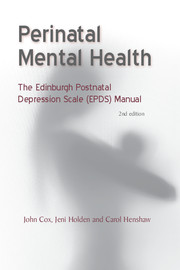Book contents
- Forntmatter
- Contents
- The authors
- Acknowledgments
- Abbreviations
- List of Figures
- Foreword
- Preface to the First Edition
- Preface to the Second Edition
- 1 Postnatal Depression: An Overview
- 2 The Origins and Development of the Edinburgh Postnatal: Depression Scale
- 3 International and Cross-Cultural Issues
- 4 Using the Edinburgh Postnatal Depression Scale in Clinical: Settings: Research Evidence
- 5 Humanistic and Person-Centred Interventions in Perinatal Depression
- 6 Screening and Intervention Services in the Community
- 7 Using the Edinburgh Postnatal Depression Scale
- Appendix 1 The Edinburgh Postnatal Depression Scale
- Appendix 2 Translations of the Edinburgh Postnatal Depression Scale
- References
- Index
7 - Using the Edinburgh Postnatal Depression Scale
Published online by Cambridge University Press: 05 February 2021
- Forntmatter
- Contents
- The authors
- Acknowledgments
- Abbreviations
- List of Figures
- Foreword
- Preface to the First Edition
- Preface to the Second Edition
- 1 Postnatal Depression: An Overview
- 2 The Origins and Development of the Edinburgh Postnatal: Depression Scale
- 3 International and Cross-Cultural Issues
- 4 Using the Edinburgh Postnatal Depression Scale in Clinical: Settings: Research Evidence
- 5 Humanistic and Person-Centred Interventions in Perinatal Depression
- 6 Screening and Intervention Services in the Community
- 7 Using the Edinburgh Postnatal Depression Scale
- Appendix 1 The Edinburgh Postnatal Depression Scale
- Appendix 2 Translations of the Edinburgh Postnatal Depression Scale
- References
- Index
Summary
This chapter summarises practical information for administering the EPDS based on research experience and on feedback from health professionals.
How to use the EPDS
1 Ask the woman to underline the response that comes closest to how she has felt during the previous 7 days.
2 Ensure that all ten items are completed.
3 The woman should complete the EPDS herself, unless she has difficulty with reading, and she should not discuss her answers with anyone other than the health professional when completing the scale.
4 The EPDS can be used routinely to screen for postnatal depression or to provide further information before referral of a woman who seems to have depression.
5 EPDS items are scored from 0 to 3; the normal response scores 0 and the ‘severe’ response scores 3. Total the individual item scores (see the EPDS scoring sheet in Appendix 1). Take care when scoring items and adding up the total as a recent study found between 13.4 and 28.9% of completed scales had errors (Matthey et al, 2013b).
6 A total score of 12 or above was taken in the three-centre study (Gerrard et al, 1994) as an indicator that the woman should be further assessed. Some authorities prefer a lower cut-off to ensure that depression is not missed (see Chapter 2).
7 Scores alone should not replace clinical judgement: women should be further assessed before deciding on treatment.
Using the EPDS in clinical practice
Routine use of the EPDS has a number of advantages.
1 It raises awareness of the possibility of postnatal depression among health professionals, women themselves and their families.
2 It may provide additional information when referring a woman to the GP or to the perinatal mental health team.
3 It can provide the opportunity for early preventive intervention.
4 It gives women ‘permission to speak’ and health professionals ‘permission to listen’.
5 It can help a woman to recognise and discuss her negative feelings.
6 It may change women's perception of what health professionals can offer.
7 It can provide a structured approach to identification of low mood or depression, clarifying the situation for both the woman and the professional.
8 It can be used to monitor progress in treatment, and Matthey (2004) has calculated that a four-point reduction in the EPDS score is a clinically significant change.
- Type
- Chapter
- Information
- Perinatal Mental HealthThe EPDS Manual, pp. 68 - 74Publisher: Royal College of PsychiatristsPrint publication year: 2014

